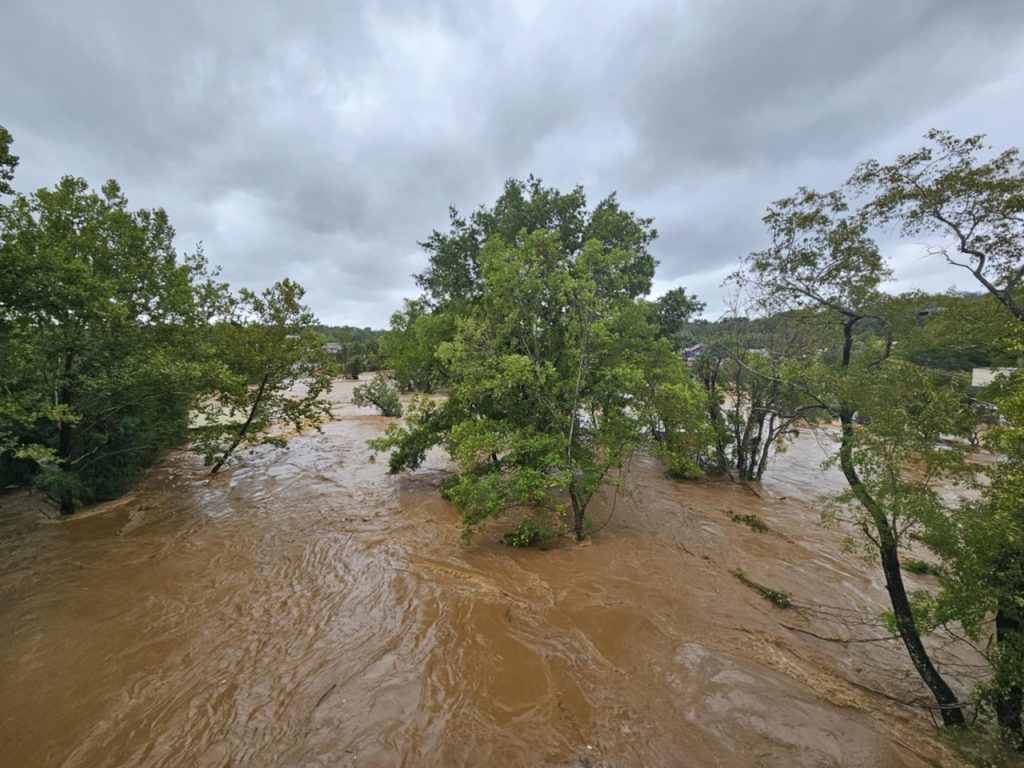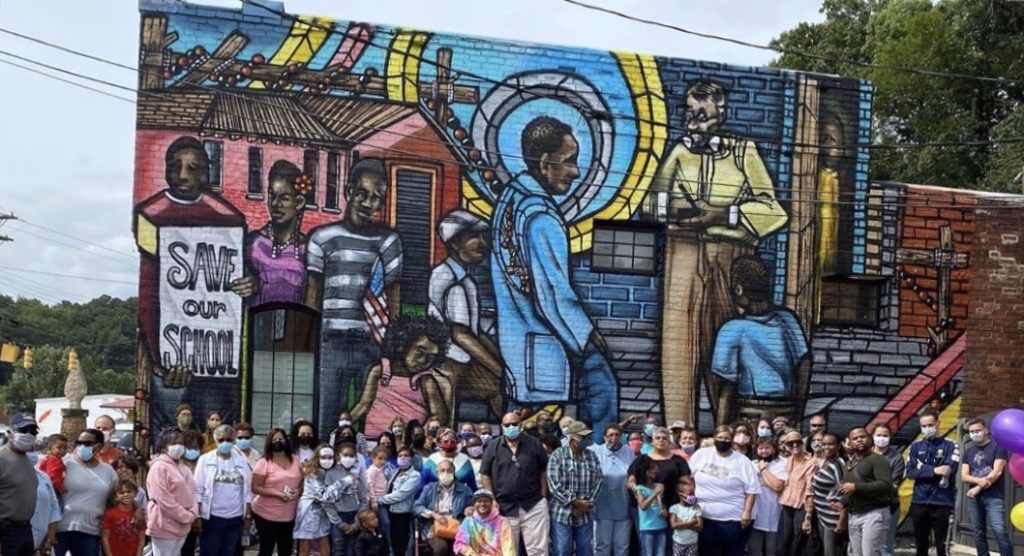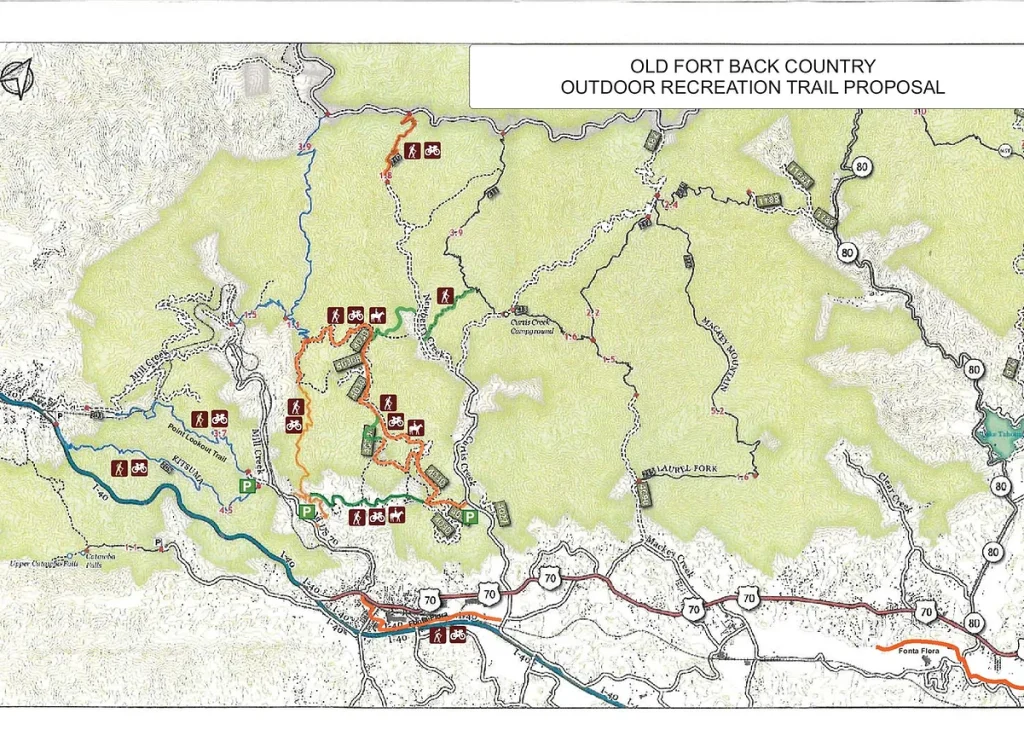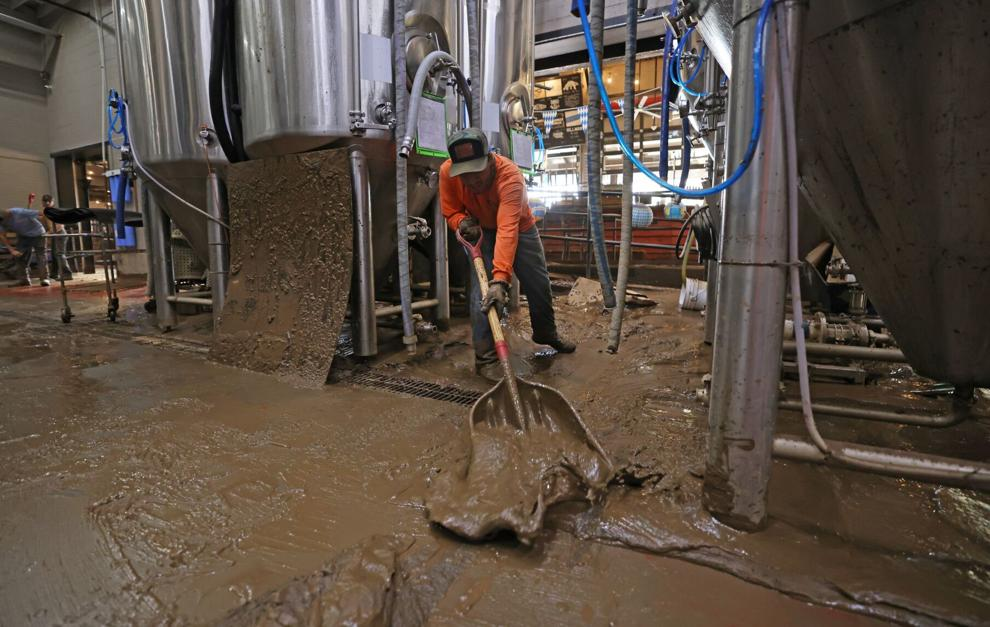Investing in Appalachia, Before and After Hurricane Helene

A mural I visited in Morganton, NC depicting elder Francisca Mendez Rodriguez as part of the Industrial Common‘s cultural work. The mural was created by Alexa Eliana Chumpitaz as part of a mural project celebrating diversity in the Catawba River Basin.
Chordata facilitates the flow of capital between investors who want a new economic system and projects that are building the solidarity economy. To fulfill that mission, a significant part of our work has to be lacing up our sneakers and getting out there to connect with solidarity economy projects happening around the country.
Over the summer, I visited Western North Carolina to meet with absolutely incredible people and communities who are building the solidarity economy in Appalachia. I’ve been heartbroken to see the devastation wrought by Hurricane Helene since my trip. The storm directly impacted many of the communities and projects I visited. This post is the story of my visit, the story of the aftermath, and a call to action.
I’d like to start by sharing a message from our partner Andrew Crosson of Invest Appalachia:
“Hurricane Helene has devastated Western North Carolina as well as other parts of Southern Appalachia. The destruction to lives and livelihoods is far beyond the scale of what the national media has been able to convey. Entire towns were swept away by floodwaters, oversaturated mountainsides erasing dozens of houses and entire extended families with a single landslide. Hundreds of thousands of people remain without water, power, or internet, and thousands have lost their homes. Basic infrastructure like roads and bridges will take months, if not years, to repair. Hundreds of businesses lost everything, and face a long road to recovery. Yet the people of Asheville and the small towns of WNC have shown incredible solidarity, strength, and generosity. Direct donations from across the country have funded incredible aid operations, and civilian supply runs kept people safe, fed, and watered in the week or so before any federal resources were broadly available. Grassroots nonprofits, mutual aid groups, faith groups, community organizations, volunteer fire departments, and others have developed incredible recovery operations and ongoing support networks.”

Swannanoa River at its peak, covering entire buildings.
Here’s how you can help in the wake of the hurricane:
Rebuilding will be a long process and funding tends to dry up entirely within a few months of a disaster like this, so local partners are working to marshall as much funding as possible now. Our partners at Invest Appalachia, along with Mountain Bizworks, and Appalachian Community Capital are developing investment strategies for immediate recovery and long-term rebuilding that center resilience and equity. We want to share this menu of investment needs with the Chordata community, and encourage you to contribute. Direct donations of $1,000-20,000 can be made through Invest Appalachia’s website. For smaller-dollar donations, please see this list of direct support options. Grants are the most helpful, followed by recoverable grants and no recourse zero interest investments (from DAFs or impact investors).
For Chordata clients – we will continue to invest in Invest Appalachia and stay connected to the work happening in the ecosystem. If you’d like to discuss additional investment opportunities, please reach out to us to set up a time to talk.

Community-led cleanups in Asheville and across WNC
My trip to Western North Carolina, before the storm
The days I spent in Western NC were deeply inspiring. I got to visit several amazing communities, and here I’ll share the story of the small town of Old Fort.
My trip started on a Thursday in June when I hopped in a car with Andrew Crosson of Invest Appalachia and drove to Old Fort, 30 min from Asheville. We drove into the mountains and all of a sudden it was just trees everywhere. Old Fort is a really small town that has been in the midst of an economic revitalization. It’s formerly a textile town in a beautiful region and was home to many different immigrant communities. The town was heavily dependent on its textile industry, and with the impacts of NAFTA over 40,000 jobs moved overseas and were lost in the area.

In 2020, People on the Move in Old Fort gathered a group of community members to produce a mural in the center of town, honoring local history that contributed to our national struggle for civil rights. The mural was painted by artist Don Rimx. Photo from oldforttogether.org
Chordata has invested 1.85 million dollars into Invest Appalachia, and the first loan they made was to this incredible powerhouse team, Jason McDougald and Stephanie Swepson-Twitty, who run the Catawba Vale Collaborative. We met up with Stephanie and Jason at a cute coffee shop in downtown Old Fort. Stephanie is local to the area and is the Director of Black- and female-led non profit developer Eagle Market Streets CDC. Jason is the Director of a special non-profit summer camp in the area, Camp Grier, and is also super dedicated to the region.
Stephanie and Jason came together around a shared question: “What’s the economic future of our community?”. In response to this, they formed the Catawba Vale Collaborative to do economic development from the ground up. Their focus has been building up ecotourism in Old Fort, which is a big economic driver. But this isn’t just any ecotourism project – they are positioning marginalized communities to take advantage of economic growth from the beginning, leading the project with a push for workforce and affordable housing, and storytelling to enrich locality and identity through community-engaged archaeology. Pretty amazing!! You can read more about how this all came to be, here.

A trail in Old Fort opened by the G5 Collective. “Once complete the trail system and other projects being spearheaded by Camp Grier and Eagle Market Street will make Old Fort a model of equitable economic development centered on outdoor recreation.” – G5 Trail Collective, photo from g5trailcollective.org
They’ve built a partnership with the Forest Service to build trail systems in the area, and for every 1 mile of trails, they believed that about 6 businesses would follow in the footsteps. They’ve woven a multiracial, “everybody thrives together” approach into everything they’re doing. For example, they shared about a project they did with the initial 6 miles of trail making it very accessible so it’s not just for the wild mountain bikers that come from other places, but also folks from the community who can go for a nice walk in the evening.

Visitors playing in the pools at the base of Catawba Falls in the Pisgah National Forest in Old Fort. Photo from Asheville Citizen Times
The kinds of businesses that often come along with ecotourism are things like breweries and coffee shops, shops selling trinkets, or outdoor excursion providers. In order to support the development of these businesses in an equitable way, they saw the need for community gathering space as well as business incubator space so that people could have affordable rent, learn trades like graphic design, or have access to a test kitchen. In order to do this, the Catawba Vale Collaborative acquired one of the anchor buildings in downtown Old Fort, a 60,000 sq. ft. former Ethan Allen furniture building, now called the Catawba Vale Innovation Market. This ended up being on of the first opportunities Invest Appalachia invested in, providing most of a $2 Million loan that had to be fast, flexible, and affordable.
I got to visit the space. It’s an enormous building right on a trail called the Fonta Flora. As we were standing outside in the heat there were 2 bike riders going by, cruising through town. I could see a wine bar that was open, and another brewery across the way. You could see the town starting to come back from what was essentially tumbleweeds after the loss of their main industries.

The Catawba Vale Innovation Market
We then drove up to see Camp Grier, where Jason is the Director. Camp Grier was started by a church post segregation and they were an intentionally integrated space, with a lot of Black folks and folks from other identity groups coming together. The way that they’re thinking about development is fascinating! They have a partnership with a local community college to do trades programs to equip folks to address some of the economic needs of the community, like construction. Camp Grier also anchors the G5 Trail Collective, which was recently awarded $2.5MM from the State of North Carolina to build the remaining 30 miles of trails that were approved by the US Forest Service in the Old Fort complex.

In 2020 the Old Fort Trails Team held numerous public Zoom session to solicit input and present tentative trail designs. This is one of the earlier proposed trail maps. Photo from G5 Trail Collective
To cap off the day, I of course had to go on a hike. The town was in the process of completing a trail system for Catawba Falls. This was a hot summer Thursday, school wasn’t even out yet, and the parking lot was full and there were so many people out there! It was a pretty grueling trek, and the path led up to a gorgeous view of waterfalls. There were people of all walks of life enjoying the beauty. I got to see what happens when you invest in the infrastructure of the ecotourism industry and how it has become an incredible economic driver. I would have loved to have a beer immediately somewhere, or get a special Old Fort hat! They expect to see half a million people coming through Old Fort now that they’ve done all this trail work.

Here I am at the Catawba Falls with Andrew. My phone says I climbed 54 flights of stairs! Thanks for believing in me, Andrew!
It was so inspiring. I’ve seen some towns die before, like my mom’s town in the central valley of CA. It was beautiful to see a really collaborative and equitable development plan that lifts everyone up together.
After the storm
I’ve been in touch with Andrew from Invest Appalachia since Hurricane Helene, and he’s shared that a lot of the places I got to visit have been deeply impacted by the storm. Here’s what he shared with me:
The town of Old Fort was heavily impacted (news story here and here). Most of the downtown ended up flooded, harming many businesses including Hillman Beer, the local brewery where we ate lunch, and lots of infrastructure was damaged.

Hillman Beer after the storm – via Winston-Salem Journal
The Catawba Vale building was just outside the flood zone – the water literally stopped at the end of the street. It has been stepping into its community purpose and serving as a storage and distribution hub for aid, serving the national guard, FEMA, and non-profits.
Camp Grier, the Old Fort nonprofit summer camp that we toured and heard about their emerging workforce housing project, was also spared direct damage and has served as a community refuge and wellness center for impacted residents, providing emergency lodging, food, showers, etc.

Facebook post from Hillman Beer – via Facebook
The trail that we hiked up to Catawba Falls was severely damaged, and it’s unclear when it will open again.
The interstate that we drove between Old Fort and Asheville was damaged by a landslide but is back mostly open.

Interstate I-40 near Old Fort, via WLOS news 13
The wine bar in Asheveille where we had a pre-dinner snack, Bottle Riot, was heavily damaged. The surrounding River Arts District was devastated, with countless businesses and buildings destroyed.

Bottle Riot, via Facebook
Investing for years to come
It has been heartbreaking to witness the devastation of these special places I got to spend time so recently, and our love and care goes out to the communities impacted. Chordata is committed to riding through the ups and downs with the folks we invest in. Climate chaos will only continue to escalate, and we know that dollars that support rebuilding in equitable ways are essential. We’re so grateful for the leadership and guidance of our partners in Appalachia.
I’m grateful that I got to be on the ground and that I now have a direct connection to these projects and communities, and I am reflecting on how deeply important it is visit these places to build relationships and really understand the back story of it all. We look forward to investing in Appalachia for years to come.

A mural I visited on the Asheville Black Cultural Heritage Trail



